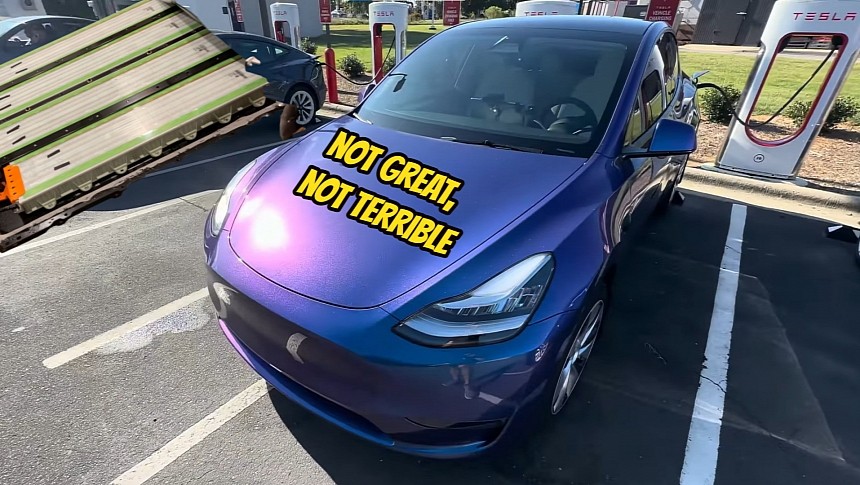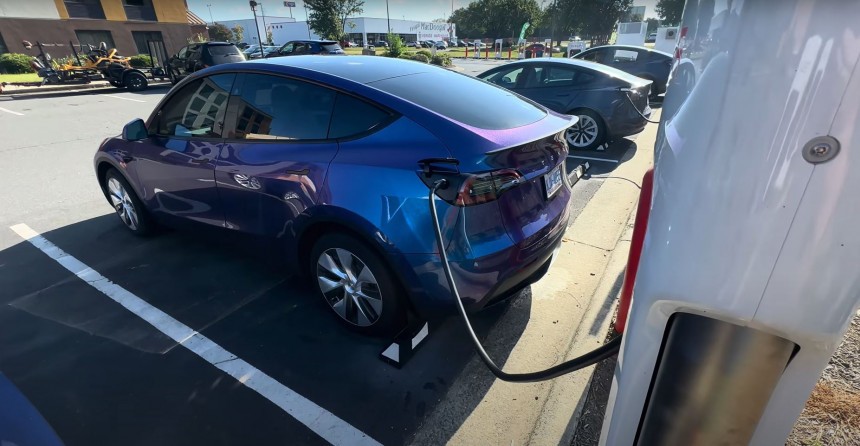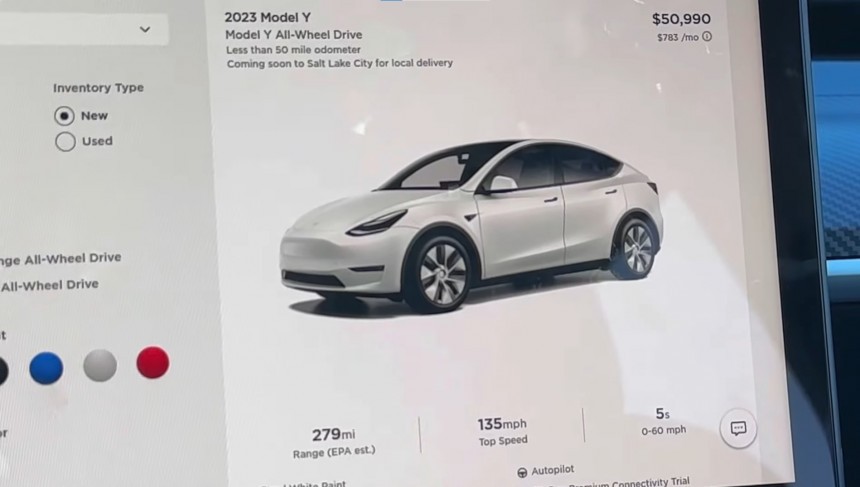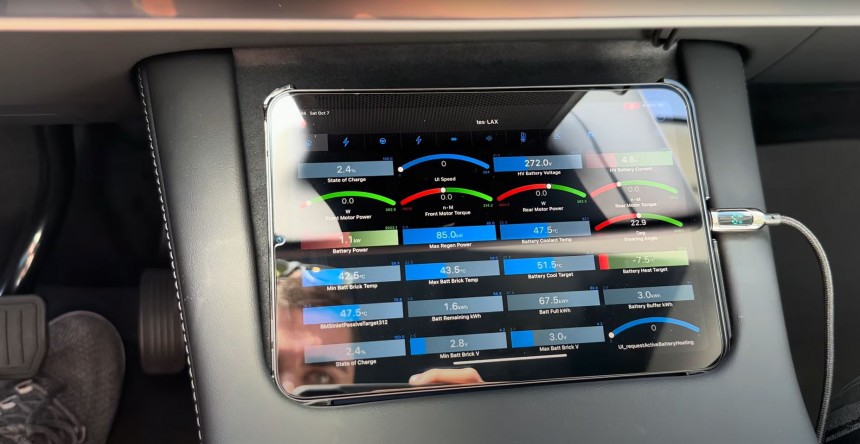For a brief period, Tesla sold a 2023 Tesla Model Y called the "All-Wheel Drive." It wasn't a "Long Range" unit. However, it had two motors. The differentiating factor was the battery. The Model Y Long Range did 330 miles on a single charge, while the Model Y All-Wheel Drive had a range of 279 miles. The latter was colloquially known as the "Standard Range." Here's how it performs when it must deal with highway speeds.
A couple of years ago, Tesla offered a Model Y Standard Range. It discontinued the vehicle after a while because it lacked a capable high-voltage energy storage unit. The EV had a maximum range estimate of 244 miles.
Earlier this year, the Standard Range made a silent return. But it didn't appear for configuration on the automaker's online platform. The crossover SUV was available in the "Existing Inventory" submenu and was named "Model Y All-Wheel Drive." They weren't used units because almost all had an odometer reading a mileage of around 50 or less.
Those who know Tesla quickly figured out that the EV was a reincarnated Standard Range, but this time presented itself with 279 miles of all-electric go thanks to the 4680 battery pack, a top speed of 135 mph, and a zero to 60 mph time of 5.0 seconds.
The 4680 energy storage unit had a cathode composed of Lithium, Nickel, Cobalt, and Manganese (Li-NMC or NCM), which is the preferable material for Li-ion batteries because it features a higher power rating and more energy density. That allows electrons to move nearly 1,000 times faster than when the cathode features the lithium iron phosphate (LFP) chemistry.
The 4680 structural battery also helps the Model Y shave off 20 lb of weight!
As such, the 2023 Tesla Model Y "Standard Range" (with all-wheel drive and the NCM battery pack) is kind of a unicorn, a "limited-edition" EV, so to say.
If it feels confusing, then keep in mind that Tesla is constantly playing around with what energy storage units its most popular EVs have. It's not a bad thing because it allows the manufacturer to have more suppliers and never run out of batteries, while competitors may struggle to get what they need.
Admittedly, it can be confusing for the customer. But when buying a used Tesla, the main things that interest you are the battery health, battery type, mileage, and general condition of the vehicle. The brand tells you what charging etiquette to follow to prolong the energy storage unit's lifespan, so don't worry about learning a ton of new stuff.
One owner decided to record a highway range test with his 2023 Tesla Model Y "Standard Range." He charged the vehicle all the way up to 100% (which is only recommended when planning an immediate trip, unlike LFP-equipped ones). The 67.5-kWh energy storage unit (with a 3.0-kWh buffer) showed no degradation after accruing nearly 11,000 miles on the odometer.
At 100% state of charge, the Model Y shows a maximum possible range of 279 miles (449 kilometers).
After one hour of driving on the highway, the state of charge dropped to 70%. The battery consumed 30% of its electrons to cover a distance of 72 miles (116 kilometers).
At 50% state of charge, the 2023 Model Y "Standard Range" consumed 32 kWh to go 114 miles (183 kilometers).
At 25% state of charge, the Tesla's computer showed it needed 48 kWh to cover 170 miles (274 kilometers). Interestingly, the OBD tool showed the actual state of charge being slightly higher – 28.5%.
At 1% state of charge (5.6% according to the OBD tool), the data showed that the Model Y traveled 222 miles (357 km). Thus, the original estimate would have been off by 57 miles (92 kilometers) if the driver had stopped to replenish the energy storage unit. However, he kept driving.
In the end, the "limited-edition" Tesla covered a distance of 229 miles (369 kilometers) in nearly three and a half hours by consuming 65 kWh of energy with an efficiency of 282 Wh per mile or 3.55 miles per kWh.
While the vehicle's computer showed a 0% state of charge, the OBD tool uncovered that there was still 2.4% or 1.6 kWh left as a reserve. However, depleting the battery's not a good idea since it's not an LFP pack.
We'll let you draw the conclusion.
Earlier this year, the Standard Range made a silent return. But it didn't appear for configuration on the automaker's online platform. The crossover SUV was available in the "Existing Inventory" submenu and was named "Model Y All-Wheel Drive." They weren't used units because almost all had an odometer reading a mileage of around 50 or less.
Those who know Tesla quickly figured out that the EV was a reincarnated Standard Range, but this time presented itself with 279 miles of all-electric go thanks to the 4680 battery pack, a top speed of 135 mph, and a zero to 60 mph time of 5.0 seconds.
The 4680 energy storage unit had a cathode composed of Lithium, Nickel, Cobalt, and Manganese (Li-NMC or NCM), which is the preferable material for Li-ion batteries because it features a higher power rating and more energy density. That allows electrons to move nearly 1,000 times faster than when the cathode features the lithium iron phosphate (LFP) chemistry.
The Tesla way
But the 2023 Model Y "Standard Range" quickly disappeared and was replaced by the Model Y RWD with an LFP battery pack.As such, the 2023 Tesla Model Y "Standard Range" (with all-wheel drive and the NCM battery pack) is kind of a unicorn, a "limited-edition" EV, so to say.
If it feels confusing, then keep in mind that Tesla is constantly playing around with what energy storage units its most popular EVs have. It's not a bad thing because it allows the manufacturer to have more suppliers and never run out of batteries, while competitors may struggle to get what they need.
Admittedly, it can be confusing for the customer. But when buying a used Tesla, the main things that interest you are the battery health, battery type, mileage, and general condition of the vehicle. The brand tells you what charging etiquette to follow to prolong the energy storage unit's lifespan, so don't worry about learning a ton of new stuff.
Not great, not terrible
Theoretically, this test should show just how road trip-ready this EV is. The unit rides on the OEM wheels with tires inflated to the recommended pressure. Acceleration is set to "Chill" and steering to "Comfort." The A/C is left on the "auto" setting.At 100% state of charge, the Model Y shows a maximum possible range of 279 miles (449 kilometers).
After one hour of driving on the highway, the state of charge dropped to 70%. The battery consumed 30% of its electrons to cover a distance of 72 miles (116 kilometers).
At 50% state of charge, the 2023 Model Y "Standard Range" consumed 32 kWh to go 114 miles (183 kilometers).
At 1% state of charge (5.6% according to the OBD tool), the data showed that the Model Y traveled 222 miles (357 km). Thus, the original estimate would have been off by 57 miles (92 kilometers) if the driver had stopped to replenish the energy storage unit. However, he kept driving.
In the end, the "limited-edition" Tesla covered a distance of 229 miles (369 kilometers) in nearly three and a half hours by consuming 65 kWh of energy with an efficiency of 282 Wh per mile or 3.55 miles per kWh.
While the vehicle's computer showed a 0% state of charge, the OBD tool uncovered that there was still 2.4% or 1.6 kWh left as a reserve. However, depleting the battery's not a good idea since it's not an LFP pack.
We'll let you draw the conclusion.















